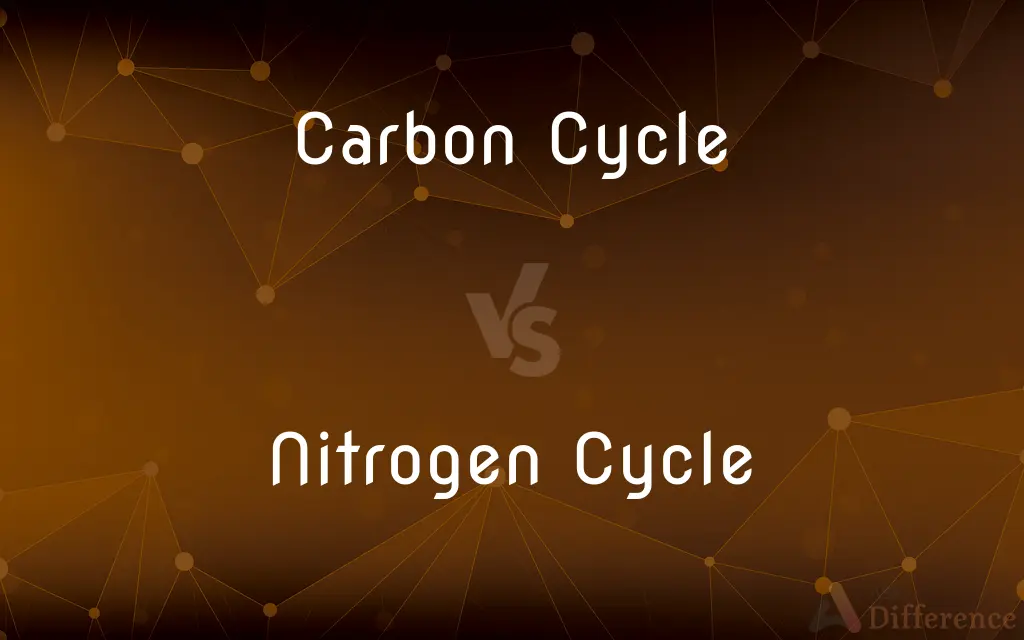Carbon Cycle vs. Nitrogen Cycle — What's the Difference?
By Tayyaba Rehman — Published on December 3, 2023
The Carbon Cycle involves the flow of carbon among the atmosphere, oceans, soil, and living organisms, while the Nitrogen Cycle describes the movement of nitrogen through the atmosphere, soil, and living beings.

Difference Between Carbon Cycle and Nitrogen Cycle
Table of Contents
ADVERTISEMENT
Key Differences
The Carbon Cycle and Nitrogen Cycle are two crucial biogeochemical cycles that regulate the flow of essential elements on Earth. The Carbon Cycle refers to the continuous movement of carbon among the atmosphere, oceans, soil, and organisms. This cycle is driven mainly by photosynthesis, which takes in atmospheric carbon dioxide, and respiration, which releases it back. The balance between these processes helps regulate Earth's climate. The Nitrogen Cycle, on the other hand, focuses on how nitrogen, an essential element for DNA and protein formation, circulates among the atmosphere, soil, and living entities.
While the Carbon Cycle emphasizes carbon's role as the foundation for life, acting as a building block for organic molecules, the Nitrogen Cycle centers around nitrogen's significance in forming proteins and nucleic acids. The Carbon Cycle has carbon dioxide and methane as its primary gases, interacting with plants and animals through processes like photosynthesis and decomposition. In contrast, the Nitrogen Cycle involves the transformation of atmospheric nitrogen into various forms like ammonia, nitrates, and nitrites, making it available to plants and subsequently animals.
Human activities impact both the Carbon Cycle and the Nitrogen Cycle. The Carbon Cycle has been disrupted by the burning of fossil fuels, deforestation, and industrial processes, leading to an accumulation of greenhouse gases in the atmosphere and contributing to global warming. The Nitrogen Cycle, too, has been affected, especially by agriculture, where the excessive use of nitrogen-based fertilizers disrupts natural nitrogen balances, leading to problems like water pollution and soil acidification.
In essence, the Carbon Cycle and Nitrogen Cycle play pivotal roles in maintaining Earth's environmental balance. While the Carbon Cycle is vital for regulating global climate and providing the framework for life, the Nitrogen Cycle ensures that organisms have access to the nitrogen they need for growth and reproduction. Recognizing the differences and interplays between these cycles is critical for understanding ecological dynamics and the broader environment.
Comparison Chart
Element Involved
Carbon.
Nitrogen.
ADVERTISEMENT
Primary Gases
Carbon dioxide and methane.
Nitrogen gas, ammonia, nitrites, and nitrates.
Processes
Photosynthesis, respiration, decomposition.
Nitrogen fixation, nitrification, denitrification.
Human Impact
Burning fossil fuels, deforestation.
Overuse of fertilizers, burning fossil fuels.
Function
Regulate climate, provide life framework.
Provide essential nitrogen for growth and reproduction.
Compare with Definitions
Carbon Cycle
The Carbon Cycle denotes the flow of carbon in various forms across the planet.
Deforestation hampers the Carbon Cycle by reducing trees that store carbon.
Nitrogen Cycle
The Nitrogen Cycle refers to the circulation of nitrogen among atmosphere, soil, and living organisms.
Overusing fertilizers can disrupt the Nitrogen Cycle, leading to water pollution.
Carbon Cycle
The Carbon Cycle represents the continuous exchange of carbon among living and non-living entities.
Soil is an essential component of the Carbon Cycle, acting as a carbon sink.
Nitrogen Cycle
The Nitrogen Cycle denotes how nitrogen changes forms and locations in the environment.
Plants acquire nitrogen through the Nitrogen Cycle to produce proteins.
Carbon Cycle
The Carbon Cycle is the process by which carbon moves through Earth's spheres.
Plants play a crucial role in the Carbon Cycle by absorbing carbon dioxide during photosynthesis.
Nitrogen Cycle
The Nitrogen Cycle encapsulates the processes turning atmospheric nitrogen into usable compounds.
Denitrification in the Nitrogen Cycle returns nitrogen to the atmosphere.
Carbon Cycle
The Carbon Cycle refers to the circulation of carbon among atmosphere, land, and oceans.
The burning of fossil fuels disrupts the natural balance of the Carbon Cycle.
Nitrogen Cycle
The Nitrogen Cycle describes the transformation and movement of nitrogen in different forms.
Bacteria play a vital role in the Nitrogen Cycle by converting atmospheric nitrogen into usable forms.
Carbon Cycle
The Carbon Cycle encapsulates how carbon transitions between different states and locations.
The oceans play a significant role in the Carbon Cycle by absorbing vast amounts of carbon dioxide.
Nitrogen Cycle
The Nitrogen Cycle represents the continuous exchange of nitrogen in various stages.
Lightning contributes to the Nitrogen Cycle by helping fix atmospheric nitrogen.
Common Curiosities
Why is the Carbon Cycle significant?
It regulates Earth's climate and provides the foundational element for organic life.
What is the Carbon Cycle?
The Carbon Cycle is the process by which carbon circulates among the atmosphere, oceans, soil, and living organisms.
How does deforestation affect the Carbon Cycle?
It reduces trees that absorb and store carbon, leading to higher atmospheric carbon dioxide levels.
How do human activities impact the Carbon Cycle?
Activities like burning fossil fuels and deforestation disrupt the natural balance of the Carbon Cycle.
What are the main components of the Nitrogen Cycle?
Nitrogen fixation, nitrification, and denitrification are key processes.
How does the Nitrogen Cycle differ from the Carbon Cycle?
While the Carbon Cycle focuses on the flow of carbon, the Nitrogen Cycle revolves around the transformation and movement of nitrogen.
How do plants contribute to the Carbon Cycle?
Through photosynthesis, plants absorb carbon dioxide and release oxygen.
Can the Nitrogen Cycle affect water quality?
Yes, overuse of nitrogen-based fertilizers can disrupt the Nitrogen Cycle, leading to water pollution.
Why is nitrogen fixation important in the Nitrogen Cycle?
It transforms inert atmospheric nitrogen into a form plants can absorb.
Are there any human activities beneficial to the Nitrogen Cycle?
Sustainable farming practices and wastewater treatment can support a balanced Nitrogen Cycle.
How does the Nitrogen Cycle support life?
It ensures organisms receive the essential nitrogen they need for growth and reproduction.
What role do bacteria play in the Nitrogen Cycle?
Bacteria help convert atmospheric nitrogen into forms plants can use.
What's the connection between the Carbon Cycle and global warming?
Disruption in the Carbon Cycle, especially from burning fossil fuels, leads to excess greenhouse gases, causing global warming.
What can balance the Carbon Cycle?
Conservation efforts, afforestation, and sustainable practices can help restore the Carbon Cycle's balance.
Share Your Discovery

Previous Comparison
Photosystem 1 vs. Photosystem 2
Next Comparison
Ticks vs. LiceAuthor Spotlight
Written by
Tayyaba RehmanTayyaba Rehman is a distinguished writer, currently serving as a primary contributor to askdifference.com. As a researcher in semantics and etymology, Tayyaba's passion for the complexity of languages and their distinctions has found a perfect home on the platform. Tayyaba delves into the intricacies of language, distinguishing between commonly confused words and phrases, thereby providing clarity for readers worldwide.
















































